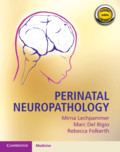Book contents
- Perinatal Neuropathology
- Perinatal Neuropathology
- Copyright page
- Contents
- Preface
- Acknowledgments
- Abbreviations
- Section I Techniques and Practical Considerations
- Approach to Autopsy of the Perinatal Nervous System
- Ancillary Studies
- Prosection Techniques
- Tissue Selection
- Chapter 13 Selection of Brain Areas for Microscopic Examination
- Chapter 14 Technical Considerations in Perinatal CNS Tissue Processing
- Chapter 15 Staining Techniques
- Reporting
- Section 2 Human Nervous System Development
- Section 3 Stillbirth
- Section 4 Disruptions / Hypoxic-Ischemic Injury
- Section 5 Malformations
- Section 6 Perinatal Neurooncology
- Section 7 Spinal and Neuromuscular Disorders
- Section 8 Eye Disorders
- Section 9 Infections: In Utero Infections
- Section 10 Metabolic / Toxic Disorders: Storage Diseases
- Section 11 Forensic Neuropathology
- Appendix 1 Technical Considerations in Perinatal CNS
- Index
- References
Chapter 14 - Technical Considerations in Perinatal CNS Tissue Processing
from Tissue Selection
Published online by Cambridge University Press: 07 August 2021
- Perinatal Neuropathology
- Perinatal Neuropathology
- Copyright page
- Contents
- Preface
- Acknowledgments
- Abbreviations
- Section I Techniques and Practical Considerations
- Approach to Autopsy of the Perinatal Nervous System
- Ancillary Studies
- Prosection Techniques
- Tissue Selection
- Chapter 13 Selection of Brain Areas for Microscopic Examination
- Chapter 14 Technical Considerations in Perinatal CNS Tissue Processing
- Chapter 15 Staining Techniques
- Reporting
- Section 2 Human Nervous System Development
- Section 3 Stillbirth
- Section 4 Disruptions / Hypoxic-Ischemic Injury
- Section 5 Malformations
- Section 6 Perinatal Neurooncology
- Section 7 Spinal and Neuromuscular Disorders
- Section 8 Eye Disorders
- Section 9 Infections: In Utero Infections
- Section 10 Metabolic / Toxic Disorders: Storage Diseases
- Section 11 Forensic Neuropathology
- Appendix 1 Technical Considerations in Perinatal CNS
- Index
- References
Summary
Traditionally, autopsy comprises of gross and microscopic examination, which routinely involves tissue fixation, processing, and paraffin embedding. Perinatal autopsies present with a variety of challenges, not the least of which involves the removal and examination of the immature brain. Even if great care is taken during brain removal, one may be left with an amorphous, semifluid mass of softened tissue by the time the brain is ready for fixation and further processing [1]. Therefore, in Appendix 1, we summarize the preparation of recommended fixative, manual, and automated procedures for the processing of perinatal brain tissue, which in our experience help to preserve CNS morphology and allow further downstream tissue studies.
- Type
- Chapter
- Information
- Perinatal Neuropathology , pp. 62 - 64Publisher: Cambridge University PressPrint publication year: 2021

